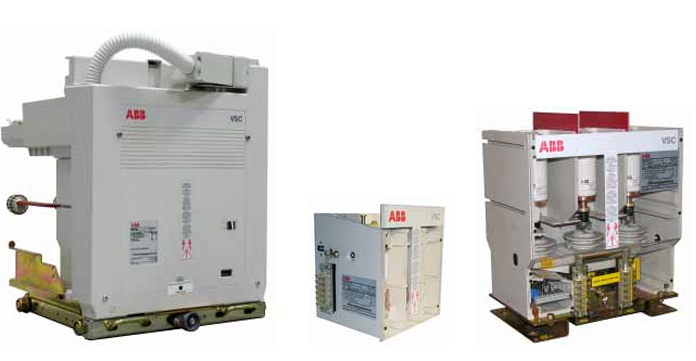ABB molded case circuit breaker
Product Series and Certification
Series Overview
ABB’s Tmax, Isomax, and Emax series molded case circuit breakers comply with UL 489 and CSA C22.2 standards, covering a current range of 15A to 2500A with a breaking capacity of up to 150kA (480V AC).
The product belongs to the IndustrialIT certification system and can be integrated into the ProtectIT suite, supporting collaborative work with distribution board components. Some models (such as T4 and T5) have e-plug communication interfaces.
Core features
Compact design: The depth of small-sized models is unified (such as 70mm for T1-T3), saving installation space.
Double insulation: Except for Isomax S8, electrical accessories can be installed on site to enhance safety and convenience.
Modular design: supports fixed, plug-in, and pull-out installations, with standardized accessories for easy maintenance.
Product Classification and Technical Parameters
1. Tmax series (15A-600A)
Model subdivision: T1-T5, covering 15A-600A, supporting thermal magnetic or electronic release devices (such as PR221DS, PR222DS/P).
Technical highlights:
T4/T5 has high breaking capacity and low let through energy limitation, reducing the impact of short-circuit current.
The electronic release supports overload (L), short circuit (S/I), and ground fault (G) protection, with adjustable parameters (such as I ₁=0.4-1 × In).
Application scenarios: power distribution, motor protection (MCP), isolation switch (MCS).
2. Isomax series (800A-2500A)
Model subdivision: S6-S8, covering 800A-2500A, using electronic release devices (PR211/P, PR212/P).
Technical highlights:
S6-S7 supports pull-out installation, while S8 is fixed with a breaking capacity of 125kA (480V AC).
Equipped with Modbus/Lon communication interface (PR212/D), it can be integrated into industrial networks.
Application scenarios: Medium to large power distribution systems, emergency power switching.
3. Motor Control and Protection (MCP)
Special models: T2-T3, S6-S8, equipped with adjustable magnetic release (6-12 × In) or electronic release (PR221DS-I).
Function: For three-phase asynchronous motors, it supports instantaneous protection against overload and short circuit, and adapts to different starting modes.
4. Isolation switch (MCS)
Model: Based on T1-T5 and S6-S8, without trip function, used for line isolation or switching.
Key technical parameters
Electrical performance
Rated voltage: AC 480V/600V, DC 500V, supports three-phase/single-phase systems.
Breaking capacity: For example, T2 has a breaking capacity of 65kA at 480V AC, and S8 can reach 100kA at 480V AC.
Release characteristics: thermal magnetic release (fixed/adjustable threshold), electronic release (LSIG four stage protection).
Machinery and Environment
Operating lifespan: Mechanical lifespan 20000-25000 cycles, electrical lifespan 8000 cycles (415V AC).
Working temperature: -25 ℃ -70 ℃, storage temperature -40 ℃ -85 ℃, humidity ≤ 90% (non condensing).
Attachments and Extended Features
Communication and Monitoring
The electronic release supports Modbus RTU and LonTalk protocols and can be connected to SCADA systems.
Display unit (FDU) monitors current and fault records in real-time.
Safety and Control Accessories
Release devices: shunt release (SOR), undervoltage release (UVR), residual current release (RC221/222).
Operating mechanism: rotary handle (RHD/RHE), energy storage motor (MOE), mechanical interlock.
Signal and indication: auxiliary contact (AUX), alarm contact (SY), position contact (AUP).
Installation accessories
Terminal cover (IP40), phase partition, DIN rail mounting bracket.
Installation and Design Specifications
Environmental requirements
When the altitude is ≤ 2000m, the rated voltage needs to be reduced to 522V if it exceeds 6600ft.
The working temperature under forced air cooling is ≤ 70 ℃, and heat dissipation needs to be evaluated in high-temperature environments.
Spacing and Protection
Center distance between adjacent circuit breakers: T1-T3 ≥ 76mm, S6-S8 ≥ 210mm.
Protection level: The terminal cover provides IP40 protection against electric shock and foreign object intrusion.
Wiring and Debugging
Supports copper/aluminum cables, with terminal types including front wire (F), rear wire (R), and extension wire (EF/ES).
The debugging tool (PR010/T) can test the trip function and configure protection parameters.
Application and Industry Solutions
Distribution system: used for main distribution boards and distribution boxes, supporting selective protection coordination.
Industrial automation: integrated into PLC control system to achieve remote monitoring and fault alarm.
Architecture and Infrastructure: Emergency Power Switching (ATS010 Controller) for Hospitals and Data Centers.
Standards and Compliance
Compliant with UL 489, CSA C22.2, IEC 60947-2, passed EMC, tropical, and vibration tests.
Environmental certification: compliant with ISO 14001, recyclable materials, and lithium battery processing must comply with safety regulations.




![MVME162-031 MOTOROLA 逻辑控制主板处理模块[品牌 价格 图片 报价]-易卖工控网](https://img2.fr-trading.com/0/5_779_2374010_651_659.jpg.webp)







